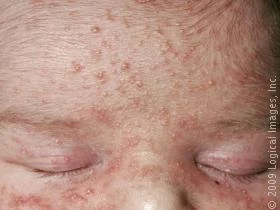Overview
Babies can develop
blemishes on their face that looks exactly like acne commonly seen in teens.
Although the cause of baby acne is unknown, it may be the result of maternal or
infant hormones (androgens) stimulating glands in the face to produce oil, or sebum.
Baby acne can essentially be divided into 2 groups: neonatal acne, which
affects babies in their first month of life; and infantile acne, which
typically affects babies 3–16 months o
f age. Neonatal acne that is confined to
the face is called benign cephalic pustulosis, while infantile acne is usually
more severe than neonatal acne and consists of more lesions. The later form may
last a few weeks to a few months, but most cases usually resolve by age 3.
 |
| Neonatal Acne - Baby Acne |
Neonatal acne occurs
in about 20% of newborns. Infantile acne appears to be less common. Males tend
to be more affected than females, although this reason is unknown.
Baby acne consists of
multiple red, raised pimples and pus-filled bumps, commonly found on the baby's
face, neck or trunk. Skin can have blackheads and whiteheads present as well.
Pitting and scarring of the affected areas can occur in approximately 10–15% of
affected infants.
In mild cases of baby
acne, using a daily cleanser is usually the first step in treatment. Gentle,
fragrance-free cleansers are best and should be applied to the affected area
daily. Newborns and infants have very sensitive skin, so vigorous scrubbing
should be avoided.
In general, baby acne
is harmless and does not require urgent care. If you have any questions or feel
that the acne on your baby's skin is worsening despite using daily cleansing
with a gentle soap, it is best to see your pediatrician. Additionally, if your
baby is prone to scratching or picking at these lesions, there is a risk the
affected areas could develop a bacterial skin infection, and it is best to seek
further medical care.
In mild cases,
prescription therapy is generally unnecessary, and the lesions may resolve with
gentle cleansing of the skin. The first-line treatment most physicians
prescribe is 2.5% benzoyl peroxide. This is an gel that is applied to the skin;
it is a commonly used acne product. It is generally well tolerated but may
cause dryness. The next line of therapy, in severe cases, is to add an oral
antibiotic. Most infants are able to stop oral antibiotics within 18 months.
Rarely, cases of acne could be made worse by a fungus, which would require a
topical antifungal applied to the skin for treatment. Your baby's pediatrician
may request the help of a pediatric dermatologist for severe cases of acne.
Furthermore, in severe cases or those resistant to therapy, an investigation
for an underlying hormonal (endocrine) disorder may be warranted.
http://bit.ly/1zmA7sB

Post a Comment